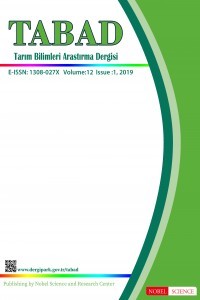Bringing Lavander to Economy in Rural Development and Rural Tourism Scope
Aromatic plant, Lavander, Lavander culturvation, Rular tourism, Rular devolopment
___
- E.Marshall, Helaty and wealth from medicinal aromatic rural Infrastructure and agro-industries division. Food and Agriculture Organization of the United Nations Rome ISSN 1810-0775, FAO Diversifcation booklet number:17 (2011).
- N. Kara, Determınatıon of lavender (Lavandula sp.) cultıvars suıtable for essentıal oıl production and studıes on mıcropropagatıon possıbılıtıes. PHD thesis, Suleyman Demirel University, Isparta (2011), pp. 1-15.
- K. Swanepoel and W. Albert, Essentıal oıl crops production guidelines: lavender production. Directorate Agricultural Information Services Department of Agriculture, South Africa (2009), pp. 1-10.
- H. Baydar and N. Kara, Impact of lavender’s additive substances added to distillation water in essential oil rate and quality. Süleyman Demirel University Faculty of Agriculture magazine, 8 (2) (2013), pp.52-58
- C. Sağlam, G. Özdemir and L. Çinkılıç Medıcal - aromatıc plants and nutrıtıonal plants that can transfer ın TR21 agrıcultural productıon. Trakya Development Agency Report, Tekirdağ (2015), pp. 21-32.
- H. Baydar and N. Kara, Essential oil characteristics of lavandins (Lavandula x intermedia Emeric ex Loisel.) of Isparta Province, Kuyucak District, Where Lavender Production Center of Turkey. Selçuk Agriculture and Food Sciensis Magazine, 25 (4) (2013), pp.41-45.
- R. Monge, Les routes de la Lavande : au carrefour du développement culturel et de la valorisation de la ressource. routes touristiques et itin´eraires culturels, Routes touristiques et itin´eraires culturels, entre m´emoire et d´eveloppement. Canada (2012), pp. 139-147.
- Başlangıç: 2008
- Yayıncı: Nobel Bilim ve Araştırma Merkezi Limited
Ziynet YIGIT, A. Omer AKMAN, Merve ALKAN, İhsan OCAL, Aysun CELIK
Gastronomi Turizminde Bitkisel Çayların Yeri: Beypazarı Örneği
In Vitro Haploidy Techniques in Ornamental Plants
Mehmet TÜTÜNCÜ, Tolga İZGÜ, Başar SEVİNDİK, Yesim YALCIN MENDİ
The Importance of Mapping Natural and Cultural Routes in Rural Tourism: Bartın Case
Sevgi GÖRMÜŞ, Erdoğan ATMIŞ, Hikmet Batuhan GÜNŞEN, Nuri Kaan ÖZKAZANÇ, Mustafa ARTAR
Bringing Lavander to Economy in Rural Development and Rural Tourism Scope
Ayşe Gülnihal KAHRAMAN, Ahmet Salih SÖNMEZDAĞ
